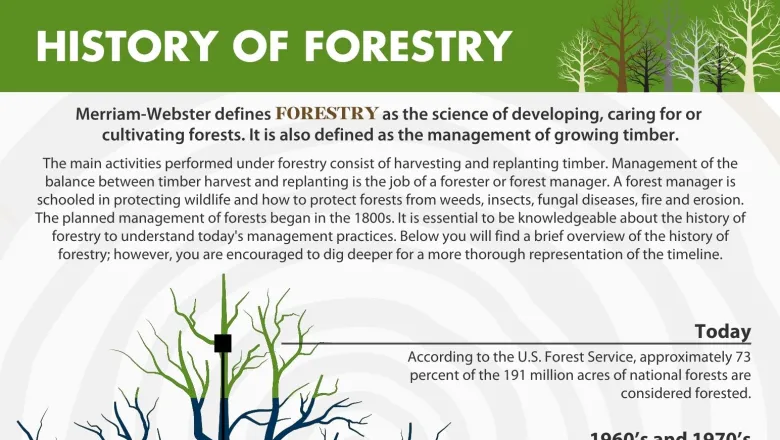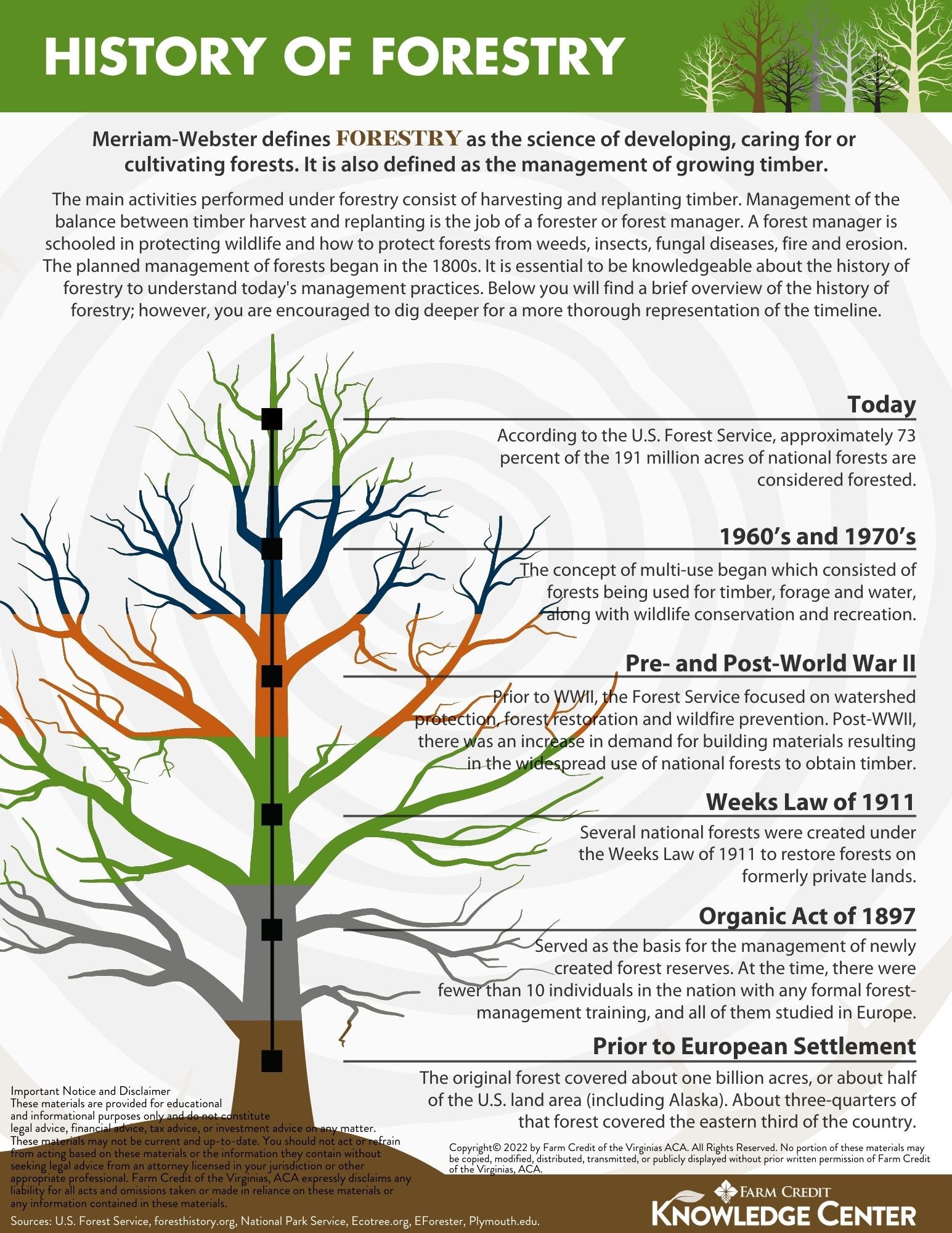History of Forestry and Forestry Definitions

Educator Resources
Forestry,
is defined by Merriam-Webster as the science of developing, caring for, or cultivating forests. It is also defined as the management of growing timber.
The main activities performed consist of the harvesting and replanting of timber. Management of the balance between timber harvest and replanting is the job of a forester or forest manager. A forest manager is also schooled in the protection of wildlife and how to protect forests from weeds, insects, fungal diseases, fire and erosion.
There are so many great topics to explore. Below you will find a brief history and a list of definitions. Read on for links to blogs and infographics covering the lifecycle of a tree, parts of a tree and an overview of some products made from trees.
History – Timeline
Download a PDF version of this infographic.

The planned management of forests began in the 1800s. It is important to be knowledgeable about the history to understand today's management practices fully. Below you will find a brief overview of the history; however, you are encouraged to dig deeper for a more thorough representation of the timeline.
Prior to the European Settlement
The original forest covered about one billion acres or about half of the U.S. land area (including Alaska). About three-quarters of that forest covered the eastern third of the country.
Organic Act of 1897
Served as the basis for the management of newly created forest reserves. The Act stated: "No national forest shall be established, except to improve and protect the forest within the boundaries, or for the purpose of securing favorable conditions of water flows, and to furnish a continuous supply of timber for the use and necessities of citizens of the United States…"
At the time, there were fewer than 10 individuals in the nation with any formal forest-management training, and all of them studied in Europe.
Weeks Law of 1911
The 1911 Weeks Law created a truly national forest system, authorizing the federal government to purchase and maintain land in the eastern U.S. as national forests (Plymouth.edu). That law authorized the Secretary of Agriculture to "…examine, locate, and purchase such forested, cutover, or denuded lands within the watersheds of navigable streams as in his judgment may be necessary to the regulation of the flow of navigable streams or for the production of timber." Many of today’s Eastern national forests were acquired under the Weeks Law. Their healthy condition today can be directly attributed to past reforestation efforts by the Forest Service and partners such as the Civilian Conservation Corps.
Pre- and Post-World War II
Prior to WWII, the Forest Service focused on watershed protection, forest restoration and wildfire prevention. During this time, there was an ample supply of private timber resulting in very little national forest logging during this timeframe.
During the housing boom of post-WWII, there was an increase in demand for building material. There was widespread use of national forests to obtain timber using the commodity-oriented harvesting technique known as clearcutting. This led to increased logging.
1960’s and 1970’s
As a result of the logging, there was an increase in environmental concerns. To protect forests, several laws were enacted. The concept of multi-use began which consisted of forests being used for timber, forage and water, along with wildlife conservation and recreation. During this same period, the United States began importing more wood than it exported. This was due to the increased demand for wood.
Today
The Forest Service operates federal timber sales under some of the world's most substantial and effective environmental protection policies (fs.fed.us). Because of this, timber sales have dropped by two-thirds even though the demand for the product increases at the rate of about one percent annually. Timber sales today are similar to the levels seen pre-1950s.
According to the U.S. Forest Service, approximately 73 percent of the 191 million acres of national forests are considered forested. Of that forested land, 35 percent is available for regularly scheduled timber harvest and about ½ of 1 percent of those trees are harvested in any 1 year. The remaining 65 percent of the forested land is designated for non-timber uses, such as wilderness and other areas set aside for recreation, or cannot be harvested due to environmental conditions, such as steep slopes and fragile soils.
ACCESS MORE: Check out our fun and engaging student activity!
Common Definitions
(sources: Pennsylvania State University Extension and DNR Maryland)
bole - the trunk of a tree
canopy - the continuous cover formed by tree crowns in a forest
clearcut - the harvest of all the trees in an area. Clearcutting is used to aid species whose seedlings require full sunlight to grow well
commercial clearcut - a harvest cut that removes all merchantable timber from the area
conifer - any tree that produces seeds in cones. See softwood
crown - the uppermost branches and foliage of a tree
deciduous - shedding or losing leaves annually; the opposite of evergreen. Trees such as maple, ash, cherry, and larch are deciduous
felling - the cutting of standing trees
forest - a biological community dominated by trees and other woody plants
forester - a degreed professional trained in forestry and forest management
forestry - the science of tending woodlands
hardwoods - a general term encompassing broadleaf, deciduous trees
harvest - the cutting, felling, and gathering of forest timber
pulpwood - wood suitable for use in paper manufacturing
pulpwood harvest - a harvest where the trees are utilized for paper pulp. This type of harvest usually is performed as a commercial thinning where the trees are all pole sized (4" to 11" d.b.h.) but definitely less than saw timber sized (11" d.b.h. or greater)
reforestation – the reestablishment of forest cover either naturally (by natural seeding, coppice, or root suckers) or artificially (by direct seeding or planting)
regeneration - the process by which a forest is reseeded and renewed. Advanced regeneration refers to regeneration that is established before the existing forest stand is removed
sapling - a tree at least 4 1/2 feet tall and up to 4 inches in diameter
silviculture - the art and science of growing forest trees
snag - a dead tree that is still standing. Snags provide important food and cover for a wide variety of wildlife species
softwood - any tree in the gymnosperm group, including pines, hemlocks, larches, spruces, firs, and junipers. Softwoods often are called conifers although some, such as junipers and yews do not produce cones
ACCESS MORE: Check out our fun and engaging student activity!
LEARN MORE:
- Learn about products made from trees and for another awesome infographic.
- Learn about the parts of a tree and for another awesome infographic.
- Learn about the lifecycle of a tree and for another awesome infographic.
Sources:
- A Historical Perspective, https://www.fs.fed.us/forestmanagement/aboutus/histperspective.shtml
- American Forests. A History of Resiliency and Recovery, https://foresthistory.org/wp-content/uploads/2016/12/American_Forests.pdf
- Dnr.state.mn.us/forestry
- Department of Forestry, Virginia
- Ecotree.green
- Eforester.org
- Museum of the White Mountains. Plymouth.edu.
- MrPolsky.com
- National Park Service
- Terminology, Pennsylvania State University Extension
